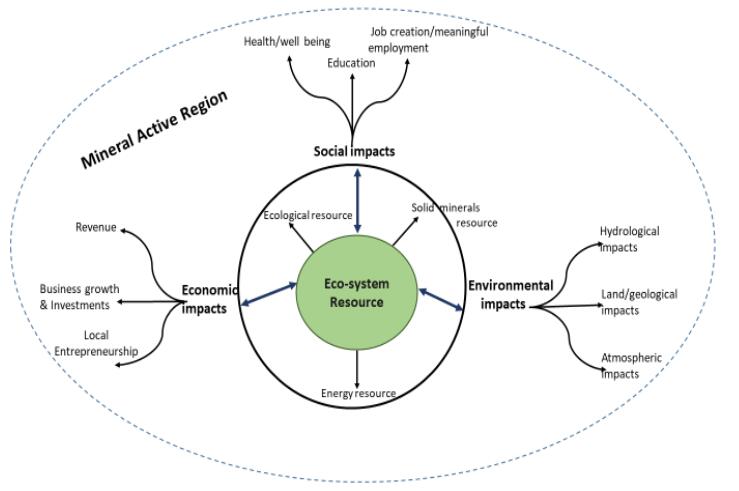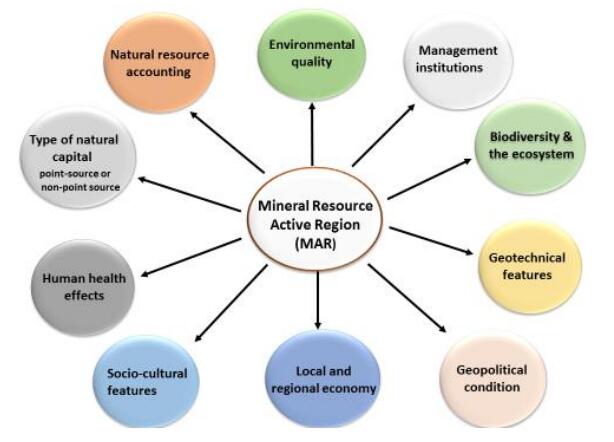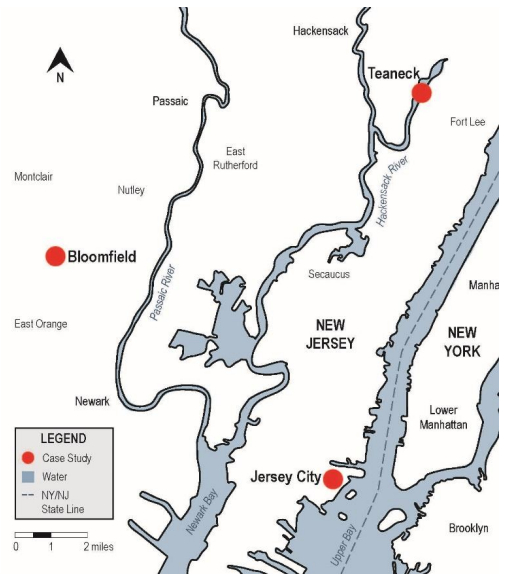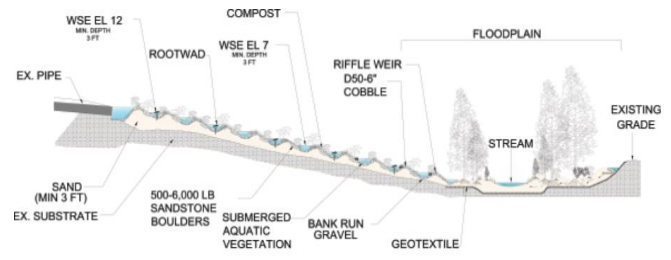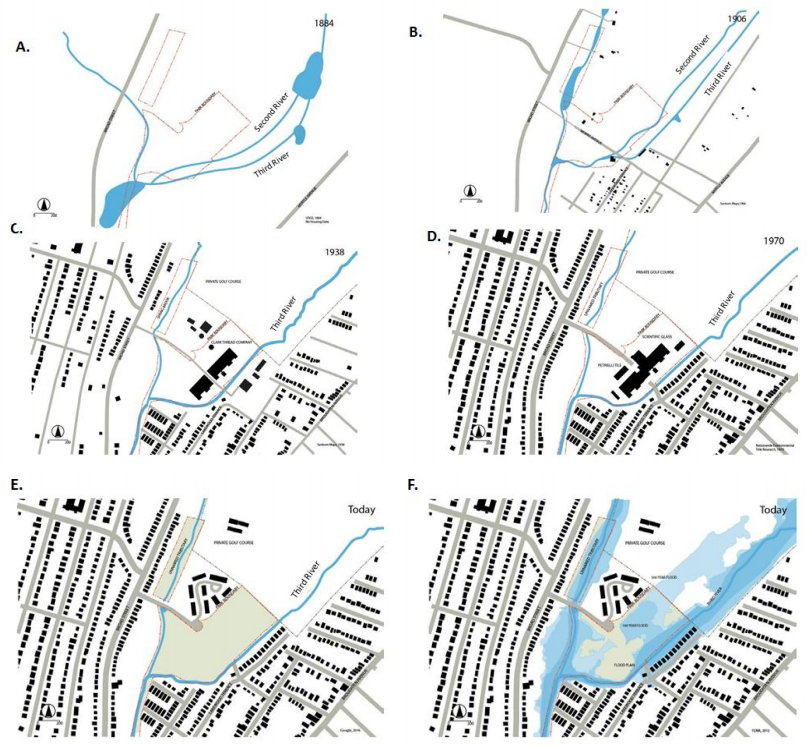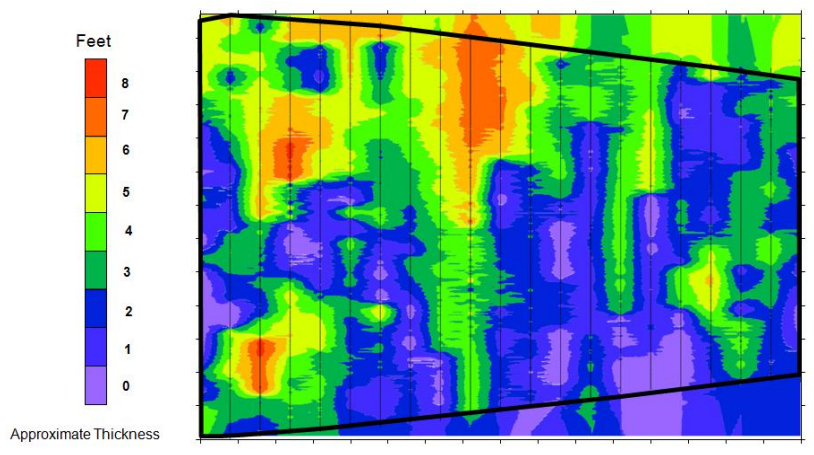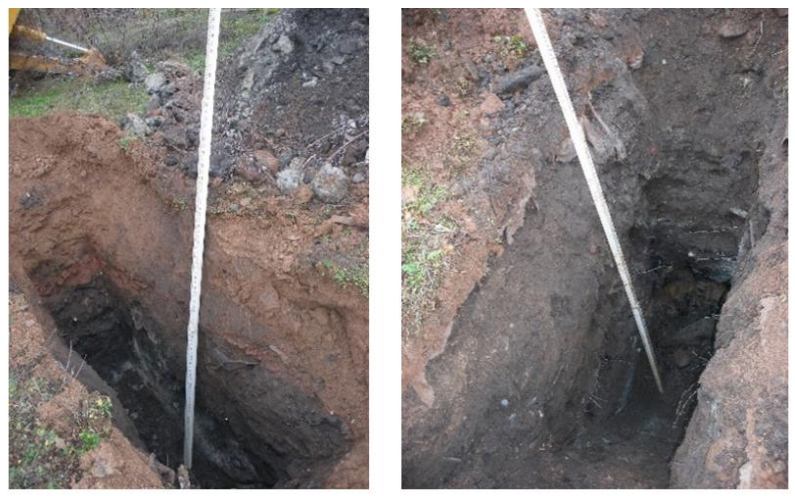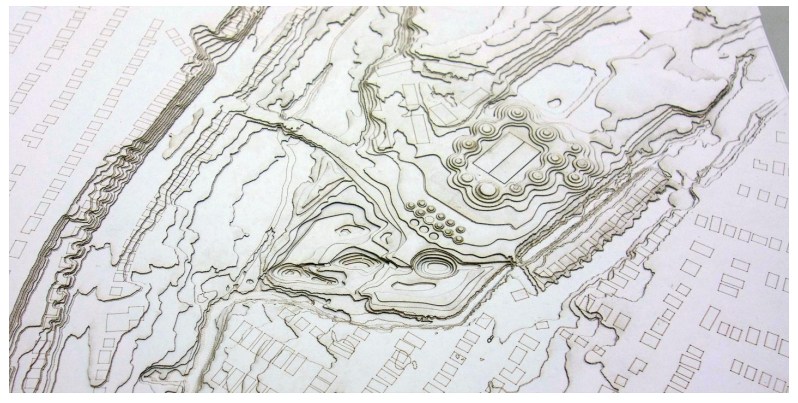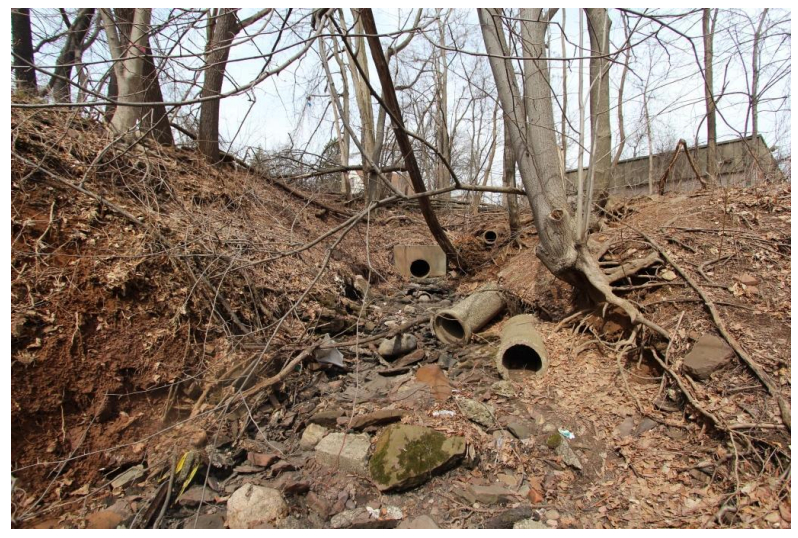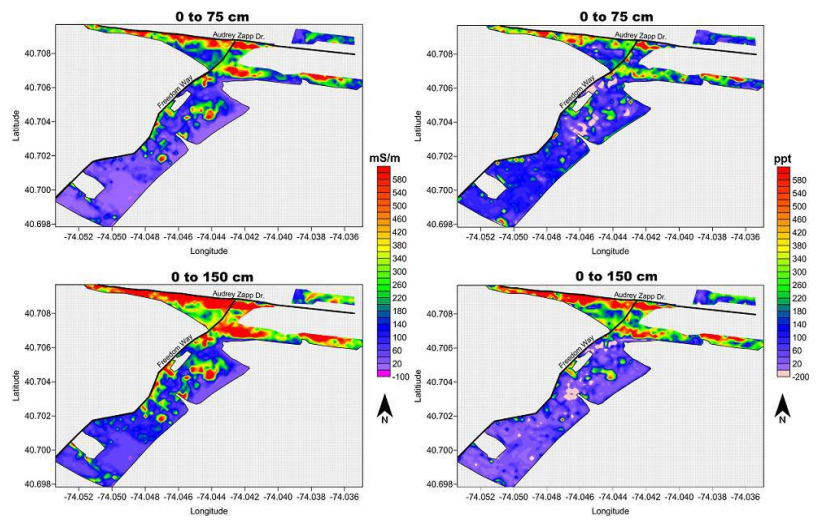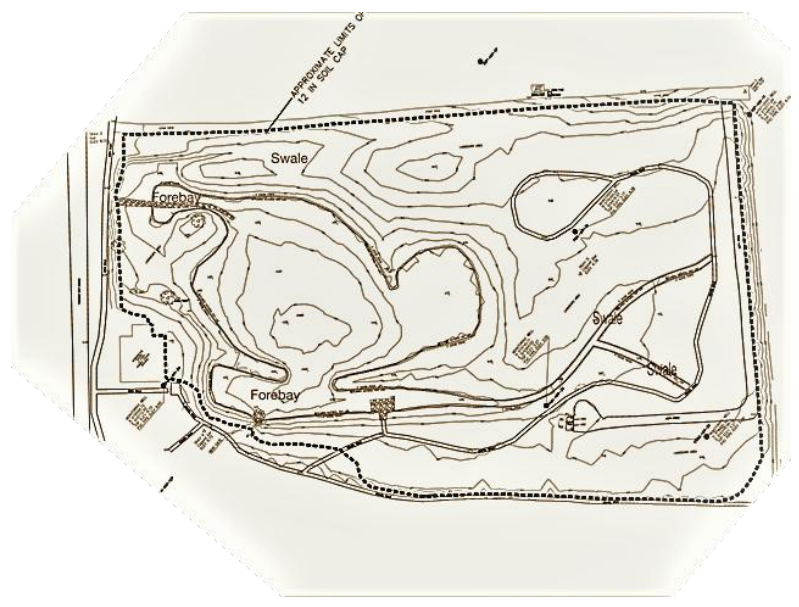1. Introduction
The natural environment is an emporium of resources; renewable and non-renewable [1]. Natural mineral resources are the lifeblood of modern civilization: the indisputable driver of unprecedented development and prosperity the world has experienced over the past century [2]. Their extraction has fuelled economic development, industrialisation, urbanisation and modern society as a whole [3]. Natural resources are broadly described as natural capital [4,5]; a term that captures those resources known to be repositories of goods and services (geodiversity and biodiversity) provided by nature. They function to preserve and stabilise natural environmental conditions, whilst provisioning resources and economic gains [6,7,8]. Profits from the exploitation of mineral resources by extracting companies are viewed as physical materials from a capitalist perspective [9]. Despite the inalienable right of all States freely to dispose of their natural wealth and resources in accordance with their national interests1, resource extraction has provided a rather difficult path to development for countries with abundant natural resources. Historically, these countries have struggled to maximize benefits to their economies. Economic exploitation of minerals and energy resources has been coupled to environmental and social consequences, that have not allowed the sustainable wealth and prosperity of the regions where the resources are extracted from. Studies have further attributed this to corruption, democratic failures, conflicts and resource wars [10,11,12], with natural resource rent-seeking associated to corruption, political instability and ultimately a slowing down of economic growth [13].
1Principle 2 of the 1992 Rio Declaration on Environment and Development
Stocks of mineral resources exist in reserves unevenly distributed in space and usually concentrated in localised geographical areas [14], with some regions more minerally active than others because of geological, spatial and temporal configuration. The variance in the geological distribution of resources, from regions of abundance to regions of scarcity, drives demand and supply relationships and constitutes the basis of international mineral and energy resource trade. These mineral resources are spatially complex [15] and could be "point-source", "fugacious" and/or "diffuse". They cannot be fully described based on geographical location since they are associated with human systems of demand and control, channels, and networks. Point source resources such as oil, gas and solid minerals attract aggressive entrepreneurship [16]. The economic viability of their extraction depends on many factors including ore grade and type, mineral quality, as well as the engineering resources available for their extraction [17,18].
Although, there have been various definitions for rich "resource regions" [18,21,22], Mineral Active Regions (MAR) here are considered those that have commercially extractable deposits of minerals or energy resources, often with historical production and on-going extractive activities, with reserves that can be used beyond their own needs. The value of the key functions of natural resources in relation to the value of resources exploited in the pursuit of economic prosperity determines the degree of exploitation, degradation, and destruction of natural capital [3,19,20]. Addressing the complexity of these regions, the paper investigates problems with their traditional management and raises the need for re-assessing these from a systems perspective.
2. Resource extraction dilemma
Mineral extraction has caused unprecedented impacts at different scales with detrimental effects on both humans and nature [2] and has been associated with a mixed legacy. Extraction activities come with significant environmental and human health effects [23,24], socio-cultural impacts [25,26,27] and ecosystem disruption and biodiversity losses in the areas where they take place [28,29,30], in addition to contributing to climate change [31,32]. Minerals, oil, and gas extracting regions experience similar socio-economic and environmental problems; with context-specific environmental problems also known to exist. For example; air pollution, toxic waste emissions, and acid rock drainage are prevalent in solid mineral extracting regions, while oil spills, drill cuttings/waste and gas flaring and venting are evident in regions where oil and gas extraction takes place. Uneven distribution of the benefits and environmental costs associated with the extractive activities is typical of these regions. Most frequently, national governments, investors, and shareholders share the benefits (in form of royalties, export earnings, taxes and rents), while local communities bare the environmental and social costs of the extraction of their mineral resources [2,33,34]. The capture of the resource wealth at the lowest cost possible, often through deliberate cases of negligence, is a serious threat to these regions. Key areas of suffering in these regions are power asymmetries and inequality [10,36], often a result of socio-political and economic exclusion, routed in vestiges of colonial-era laws and policy instruments complicit in the disempowerment of indigenous people [35]. Referred to as resource curse, this phenomenon has inspired a volume of theoretical and empirical research. Cases where resource export boom (oil as a typical case) prompt a rise in earnings leading to increased spending (public and private) causing the real exchange rate to appreciate so the non-traded sector becomes uncompetitive and consequently crowding out non-oil exports and ultimately slows down economic growth [10,37,38] are also captured by this theory. Boom-and-Bust cycles are typical of resource extraction economies, driven by profit and a tendency to thrive when demand is high, but followed by retraction as in the case of international mineral oil trade [13]. Sachs and Warner [39] have framed their argument of resource curse in relation to the crowding-out effect of entrepreneurial activity and innovation, with a rise in earnings from the natural resource sector which could stifle or disincentivise economic growth. Most researchers seem to agree with the resource curse phenomenon but often view it through different perspectives. Despite the variations in theories, the paradox is that natural resource wealth, key to economic growth and development based on conventional economic reasoning, has not delivered the benefits expected in most MARs.
The environmental impacts of extractive activities are significantly more distractive when taking place in ecologically sensitive mineral active regions. The failure to operationalise sustainability due to a lack of holistic accounting principles often with no environmental and social modifications leads to the depletion of resource stocks in these regions. The effects of extractive processes, aside from being cumulative, are characterised by high levels of technological, economic, geological and socio-cultural interactions, with associated uncertainties and ambiguities that increase the potential of often severe environmental and social impacts [40]. Oil and minerals have been contentious as point source and high-value commodities and their extraction is associated with significant loss of ecosystem services frequently at the expense of local people [41] who live in the periphery of the cash economy. Point-source resource economies often lack democratic and institutional development, which in turn hampers economic growth [36,42]. Generation of waste, environmental contamination, unequal distribution of benefits and costs, distortion of historical/cultural matrices and conflict plague these regions [41,43,44,45]. Systematic underinvestment in education, health care and infrastructure [46,47] is another characteristic of most MARs in the developing world. These characteristics drive resource decline and unsustainable growth with negative socio-economic and environmental consequences in most MARs. Examples of such regions with reference to these characteristics are presented in Table 1. They illustrate that resource extraction in these regions has been a challenge for communities, investors, policy makers and regulators, evoking the sustainability debate amongst stakeholders.
Table 1. Examples of mineral active regions and associated environmental, health and socio-economic impacts.
| Region and Activity |
Associated Problem |
Reference |
| -Mining in Pascua–Lama of Chile, Michilla and Chapaco |
Environmental degradation from tailings, effluents, dust, conflict. |
[48,49,50] |
| -Oil extraction in Cabinda and Soyo regions of Angola |
Environmental degradation from oil spills, inequity in costs and benefits distribution, conflict. |
[12,51,52] |
| -Oil and mineral extraction in the Orinoco Delta Amacuro of Venezuela |
Environmental degradation, health effects, socio-economic impacts. |
[53] |
| -Oil extraction in Niger Delta, Nigeria |
Oil spillage, gas flare, environmental and human health effects, micro-climatic changes, inequity in costs and benefits distribution, conflict. |
[8,12,32,54,55,56,57,58,59,60] |
| -Oil extraction in the Oriente region of Ecuador |
Human health effects, environmental degradation, conflict. |
[61,62,63,64] |
| -Oil extraction in the Brazilian coastal regions |
Oil spillage, environmental pollution (terrestrial and aquatic). |
[65,66] |
| -Oil extraction in Caspian and Karaganda region of Kazakhstan |
Human health effects, environmental impacts. |
[67,68] |
| -Kola Peninsula, Pechora Basin of Russia |
Pollution of waterways (lakes and bays), forest degradation, land pollution, micro-climatic impacts. |
[31,69,70,71,72] |
| -Chaco Region of Bolivia |
Environmental impacts, cultural threats, conflict. |
[41,73,74] |
| -Coatzacoalcos and Tonalá Rivers Low Basin of Mexico, Gulf of Mexico |
Oil Spillage, environmental impacts, human health effects, conflict. |
[50,75,76] |
| -Papua New Guinea |
Destruction of virgin rainforest and wetlands, aquatic pollution from toxic chemical deposit, inequity in costs and benefits distribution, conflict. |
[77,78,79,80] |
| -Mining in Australia |
Environmental degradation, human health effects, cultural threat. |
[81,82,83] |
3. Resource governance and management
Natural resources and the environment exist in a complex socio-ecological structure [84] driven by interactions between nature, technology and people. High levels of technological, economic and geological complexity characterise mineral extraction and influence intertemporal decisions [85] that cut across scales (spatial-temporal) and sectors (environment, social and economic). These intertemporal and sectorial interactions evolve to enhance the benefits derived from extractive activities or increase associated costs and environmental pressures. Historically, mineral resources management has been complex, with mineral extraction paradoxically a double-edged activity framed around economic development and environmental protection. Historical episodes of mineral extraction reveal inherent linkages and organic connections between extractive activities and society, one that holds economic potential that can sever a society from the constraints of nature [2].
Acheson [86] demonstrated three possible governance structures in resource management; provided by private property, government and community management. He argued that there is no cure-all solution to resource management; that is, while each of the groups can succeed, they can also fail depending on prevailing circumstances. Tarui [87] presented institutional management arrangements that include state property, private property, common property and open access resources management. He furthered his concept arguing that any of the institutional controls that predominate depend on the need and scarcity of the resource. This is based on the assumption that mineral resources are the driver of most economies, especially in developing countries [30], with most developed ones owning their advances to the exploitation of such resources in the past [2,88]. From Tarui's argument [87], the aim of resource exploitation is to meet states' economic needs. Examples of such states controlling mineral resources are oil and natural gas in Nigeria; oil, natural gas and diamonds in Angola; oil and natural gas in Brazil; oil, natural gas, gold and diamonds in Russia; diamonds, copper, nickel, and gold in Botswana.
Mining operations function within the formal and informal institutional frameworks of the country which hosts the mining project, and therefore inevitably acquire a political dimension, as well as strong links to its economy, ecosystem, and local communities. These communities unavoidably often come to depend on minerals production for employment, income, and broader development [89]. Resource extraction is multifaceted and has political, social and economic implications [90]. Natural resources shape and are shaped by political context, with numerous examples from mineral-rich countries demonstrating this across the world. This includes the 'making and unmaking' of laws and policies governing resource ownership and extraction. Examples include cases from Angola [52], Bolivia [41], Ecuador [73], Nigeria [54,91], where policies have been designed to disenfranchise land owners of property rights to subsurface resources [92] through nationalisation and appropriation of natural resource wealth. Despite not being an exclusive reserve of national governments, resources management has been under their purview, creating revenue for national economies through taxes and resource rents [67,93,94]. The role of governments in resource exploitation and management has engendered counter posing challenges, with government often locked in opposing and conflicting interests; as agents of economic development and custodians of the environment [95,96].
Mineral resource active regions attract multiple players with diverse interests; including international investors, government agencies and local communities [90,97] resulting in multiscale and diverse interactions that are complex and often become problematic. Studies have been conducted at different scales: national, community and site levels to investigate the many problems MARs face and to evaluate traditional management approaches. However, studies at the regional scale, looking at interactions in a more holistic way are comparatively limited. Finer and co-workers [64] advocate that studies at regional level provide an avenue for proper delineation and for resource extraction to be coupled to other systemic impacts including characterization of extracting regions. This is supported by Solomon [9], who argues that regional studies can improve governance structures while engendering sustainable development. Indeed, sustainable development is better addressed at this level, as defined with context to the eco-regional scale [98]. Traditional management approaches place emphasis on economic rationality and environmental impact mitigation measures that are ad hoc, monodisciplinary and neither integrated nor holistic, thus the primary cause for the prevailing environmental problems we are left to deal with today. Robust management must take cognisance of the uncertainties and ambiguities not considered under traditional economic thinking. Coria and Sterner [99] have argued that environmental sustainability and economic prosperity present a scenario that is only comprehensible from a multifactorial perspective whilst acknowledging that resource development and environmental stewardship are not mutually exclusive. The ecological decline coupled with the socio-economic and political exclusion of communities in MARs demonstrate that traditional environmental and resource management approaches have failed to favour policy regimes that balance environmental and social components as non-mutually exclusive components of development. These shortcomings have prompted the development of unconventional approaches with the objective of ensuring sustainable resource extraction and maintenance of environmental quality. This has operated under different nomenclatures, although with the same core objective prompting research from both the academia and public sector to embrace the Ecosystem Approach (EA) for natural resource and environmental management. The report of the Millennium Ecosystem Assessment [19] has been instrumental in broadening knowledge and improving policymaking, however, emphasis on natural resource management has been on biodiversity in contrast to geodiversity. This position may have prompted Frank and co-workers [100] to argue that terrestrial minerals are part of the ecosystem of which their extraction brings disturbance to the natural environment compared to other ecosystem resources such as fisheries or timber. Integrated Resource Management (IRM) has evolved with aspects on social, economic, technical and institutional programs to ensure a robust resource management outcome; however, Bellamy and colleagues [101] argue that fragmentation and lack of a multi-disciplinary view alongside a high dependence on engineering, biophysical and economic standards tend to limit its application.
The need to manage the balance between mineral exploitation and environmental protection has led to the formulation of management tools (legal or regulatory standards and fiscal regimes) to ensure a sustainable extractive regime at MARs. This approach has its limitations [67] as regulatory standards are often about the need of management systems rather than requirements that characterise the system per se [102]. Cumulative socio-environmental and economic impacts of extraction and associated uncertainties are a real challenge to institutions of government and have drawn concerns across mineral dependent economies [9]. The absence of a sustainable solution as documented in most MARs is clear evidence that the problem has neither been understood by resource managers and policy makers nor have the right tools been deployed to understand and manage MARs from a systems perspective. A lack of an appropriate holistic framework to manage resources, enable the delivery of desired benefits, minimise ecological decay, trade-offs and cost borne by host communities, is often observed in MARs with traditional resources management. Depleting natural resources coupled with environmental degradation caused by extractive activities in many of these areas demonstrate the need for a change from current management practices and policies towards an integrated, holistic and purpose-driven approach that reduces environmental impacts and delivers resilience and sustainability. Features of traditional and systems-based perspectives are compared in Table 2. Understanding the characteristics of the MAR system could create foundational knowledge that could change interactions and create conditions that support a more sustainable system state.
Table 2. Traditional management approaches compared to systems-based thinking in resources management.
| Traditional approach |
Systems thinking approach |
| -Emphasis on conventional economic rationality |
-Based on sustainability and seek sustainable -way out to persistent problems |
| -Rent-based |
-Interest-based |
| -Sectoral, reductionist and lack of multi-disciplinary view |
-Integrated, holistic and use of multiple perspectives |
| -High dependence on engineering and biophysical standards |
-Understanding roots problems though soft approaches, and based on client perspective |
| -Emphasis on regulatory standards |
-Emphasis on management systems |
| -Exclusion, top-down and end-of the-pipe modus operandi |
-Integration, inclusion, collaboration, bottom-up and advocates win-win solutions |
| -Confounded by complexity |
-Understand and manages complexity by thinking broadly to see interactions |
| -Focused on managing resources and meeting policy target |
-Manage resource by managing people and their interactions resulting in learning outcomes |
| -Technical and expert knowledge-driven |
-Stakeholder-driven and based on participatory approaches |
| -Results in depletion of natural resource and environmental degradation |
-Aims to ensure resilience and sustainability of natural resources and environmental protection |
4. Discussion
Mineral resource extraction stimulates multiscale interactions between numerous stakeholders, and is a source of economic gains and opportunities, as well as environmental and social impacts that evolve over time [103]. Natural resource management is characteristically complex and therefore a constraint to sustainable development [104]. Resource-environment-economy interactions in MARs are characterised by uncertainty and cognitive limitations that create complex incentives for policy.
Moreover, ecological and geological interactions mediated by humans in the quest for mineral exploitation have created complex environmental, resource and sustainability problems that are chronic and defy traditional thinking. For example, environmental, economic and social impacts of extraction have multiple and generational effects on both spatial and temporal scales [18]. Therefore, there is a clear need to harness and operationalise complexity, instead of ignoring it. When properly considered, complexity can be an opportunity rather than a threat [105]. The emergent environmental and socio-economic characteristics of MARs occasioned by mineral extraction coupled with the traditional sectoral and monodisciplinary management approaches create a complex situation because of the narrow focus on economic rationality that does not allow understanding of long-term and integrated systems management approaches. Addressing this complexity, there is an overarching need for retrospective understanding, scenario analyses and futures thinking as to understand the complex nature of interactions that exists in MARs, before any solutions are derived to manage natural resources. A conceptual diagram of the environment-social-economic nexus that exists in mineral active regions is presented in Figure 1. Addressing resource management challenges requires an understanding of the complexity of MARs by looking at the interactions and relationships between all system parts and redefining these challenges by looking at environmental and socio-economic problems as products of the interactions around the mineral extraction activity. The diagram illustrates mineral active regions as a system where interactions between its environmental, social, and economic components determine the impacts associated with the natural resources extraction.
A holistic way to understand resource constructs is by its function and relationship [9]. This view sheds light upon an organic connection between humans, the environment, the economy and natural resources. Problems associated with resource extraction cannot be attributed to the latent subsoil assets but the conditions and configuration of interests developed around their exploitation [106]. One of the prevailing problems in traditional resources management is the lack of holistic integration of the economic activity with environmental, social, political and administrative issues, necessary for an effective governance regime [25,107]. Solving environmental problems associated with resource extraction lies in understanding their root causes, reaching optimal policies and engaging technical solutions [108]. For example, problem structuring methods that are participatory allow for understanding of the causes of problems [109] more effectively than the top-down or black box techniques that have been traditionally used. Managing natural resources is about managing people rather than the resource [110]. Inability to account for micro-level decision making in designing policies may result in a policy-resistant scenario where the system's response to policy implementation defeats the design purpose. Observed in many MARs are complex yet non-inclusive resource management structures that tend to create misperceptions and misrepresentations of most stakeholders involved. Perceptions of extractive companies predispose them to suffer from the lack of trust from local communities, a reaction often to their inability to influence issues concerning their future [111,112]. This leads to blame trading amongst the international extracting companies, local communities and the government, that often results in conflict with reputational liabilities [92]. Some scholars however consider conflict an integral part of the resource extraction regime [112]. Bebbington [74] explored this view by arguing that conflict can bring change that will enhance performance and that improved performance might deflate conflict. The theory offers a paradoxical interpretation, that raises the question: why should it take conflict to advance environmental policies as part of a management approach? Conflict-driven change is tenable when a result of learning process that could lead to improved performance, but at what cost? Often it sets in motion a chain of counterintuitive perspectives, in a state of physical and moral warfare with reputational and economic consequences for all involved.
Management must therefore be inclusive and consider all interests configured around resource systems by incorporating stakeholders' perception into the decision making. Management that is not holistic in problem conceptualisation and participatory in solution design can result in unexpected environmental and social impacts [40]. For example, after extensive research in the Niger Delta region of Nigeria; Jike [113] demonstrated that resource extraction patterns when left uncontrolled can lead to irreversible changes to regional ecosystems by affecting both the natural and socio-economic environment. Most of the studies conducted (for example in the Niger Delta, Nigeria) are sectoral and reflect discipline bias, either looking at environmental contamination and ecosystem effects arising from extractive activities [56,114], biophysical effects [59,115] or socio-economic dimensions [67,116,117]. Environmental issues should be considered an administrative predicament that must be holistically understood and not the reductionist and discipline-oriented approach that is ineffective and incomprehensive at managing resource and environmental complexities [3]. Environmental quality and natural resource management are inseparable factors that should be dealt with in an integrative system without setting arbitrary socio-economic or political boundaries. Resource development and environmental stewardship are not mutually exclusive as they can be simultaneously coupled with responsible resource management, underpinned on robust policy and effective regulation and can be undertaken to bring a maximum economic contribution and improved social condition with minimal environmental damage [27]. This can be achieved if resource regimes shift from reductionist rent-based to a holistic interest-based approach that is focused on ecological integrity, sustainable mineral extraction, community rights and redistributive equity. The need for systems thinking in understanding and managing complexity in MARs is a clear prerequisite for this.
Systems thinking offers an important cross-sectoral, interdisciplinary and diagnostic alternative for understanding interactions by improving communication and providing information on the vulnerabilities and resilience of MARs. Its application in resources management can avoid policy resistance and system collapse. It addresses the need to understand interdependences in mineral resource systems and how they can be leveraged to deliver win-win solutions for both the environment and society. Traditionally, developing environmental management plans has been the domain of highly trained experts, however, the mechanistic and non-deliberative nature of this approach has been associated to several failures and counterintuitive outcomes. Moreover, conventional policy regimes that evolved from technical domains to address environmental and natural resource problems can be deterministic, mechanistic and not adaptive to address multiscalar and cross-sectorial problems confronting this generation [118]. They involve management approaches that are focused on quantifiable and measurable impacts [18] without consideration of system relationships and interactions that reflect technical and soft principles underpinned by stakeholder constructs and interests. Systems thinking is purposed to advance environmental decisions that are robust [20] since it is conceptual and contextual and involves thinking, collection of data from clients, integration of stakeholders' mental models and communication. Consequently, this approach can reduce the opacity that expert or technical driven approaches present.
Systems thinking and system dynamics are central to tackling complex problems and have been widely applied to different fields including medicine and public health [119,120]; natural environment [121,122]; farming systems and agriculture [123]; and sustainability of renewable energy [124]. Mineral active regions are inherently complex, and therefore evidence-based knowledge is required for their management to deliver effective and result oriented outcomes. There are benefits for using a soft systems approach [107,125,126], that despite being principally qualitative, allows for quantitative data to be explored to gain an understanding of the system behaviour. This approach also allows unquantifiable or soft variables that influence environmental and resource decisions to be objectively captured [20]. It needs to be participatory and allow for creative problem structuring and embedding of stakeholder interest [127] by raising awareness of the consequences and benefits of system interactions. Achieved through mediated or group model building, it involves the use of mental models, conceptual models, situation mapping and rich pictures to scope and elicit information, build consensuses, deconstruct complexity and, consequently, enable participants to see things for what they are. Acknowledging that perceptions and understanding of things differ between stakeholders, systems thinking through transdisciplinary participation can enable collective representation and integration of different perspectives so as to improve overall understanding of the system. The path to sustainability for the mineral active region is through shared knowledge [128].
Environmental problems bordering resource extraction permeate every discipline and sector; and for that transdisciplinary approaches which are broadly based and holistic take preference to discipline-based and reductionist methods. The process builds on a conceptual model for a MAR, with defined system components (type of natural capital, natural resource accounting mechanism and principles, management institutions, environmental quality, biodiversity and ecosystems, geotechnical features, geopolitical condition, local and regional economy, socio-cultural features, human health effects) subsumed in the environmental, economic, social, and institutional sustainability tetrad (Figure 2). The main purpose of this representation of a MAR system is not to analyse the interactions but to facilitate the process of understanding the systems components of a MAR and explore the interactions that directly or indirectly drive sustainability problems.
The application of systems thinking in the management of MARs should therefore be further investigated because of its potential to deliver integrated and holistic solutions that could benefit all involved while maintaining ecological integrity. Investigating the systemic effects of mineral extraction in MARs; their contribution to the economic liberation of nations, attendant environmental and social impacts as well as the effect on the geopolitical landscapes of countries with natural resource assets, offer ways to address the complexity of these regions. Mineral extraction draws divergent interests and affects stakeholders differently in terms of cost and benefits distribution, while studies have shown that extractive industries' successes can be ensured when corporate interest aligns to regional and community interests and values. The awareness of the interdependences between the various players and sectors allows for the type of collaboration that could lead to a sustainable extractive regime [33]. This also requires taking down barriers such as weak laws and bad resource governance regimes, leaving behind reductionist, monodisciplinary and rent-based rationalities.
5. Conclusion
System thinking in the management of MARs has the potential to deliver benefits through the understanding of the links between system components, their interactions, and interdependencies. Using conceptual models of the relationships and interactions that characterise MARs, and through a multidisciplinary approach, system tools can empower stakeholders enabling them to see these interactions and interdependencies. Critical gaps and barriers that undermine efforts to sustainable resource extraction and management become visible, allowing for more collaborative and participatory management. Accounting for spatial-temporal and sectorial issues, such participatory approaches involve gathering historical and contemporary views on MARs, creating a collective representation based on the integration of different perspectives. Systems tools treat mineral active regions as integrated catchments, complex systems open but with spatial and temporal boundaries. This does not mean that systems-based methodologies can provide an all-encompassing solution, instead, they enable stakeholders to redefine the problems they face and even make the need for management solutions obsolete.
Acknowledgments
We wish to acknowledge the Petroleum Technology Development Fund for providing the scholarship for one of the authors of this work (PTDF/E/OSS/PHD/AAC/588/14).
Conflict of interest
All authors declare no conflicts of interest in this paper.









 DownLoad:
DownLoad: 